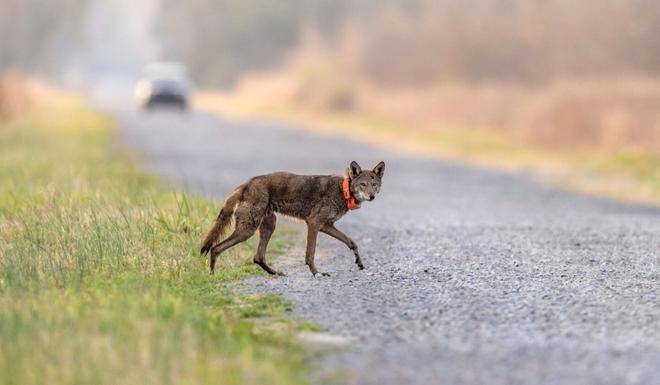Can Road Tunnels Help Save Last Wild Population of `America’s Wolf?’- wna24

Representative image. | Image:
AP
Every year, on average, 5% of the world’s wild red wolf population dies an unnatural death. But it’s not hunters killing the planet’s most endangered canid _ it’s motorists.
Vehicle strikes are the leading cause of mortality for Canis rufus, the only wolf species unique to the United States.
This fact was brought home in devastating fashion last June, when breeding male 2444 was struck and killed on US 64 in eastern North Carolina. As a result of his death, the five pups for whom he was providing also perished.
“The body had been moved off the highway when the wildlife crew, red wolf crew got here,” Joe Madison, who runs the red wolf program for the U.S. Fish and Wildlife Service, said during a recent, rainy visit to the site.
“You know, one red wolf represents, you know, out of 16, that’s 7% of the population,” he said. “So, every time you get a mortality, that’s a significant hit.”
“Five of them have been killed by vehicle strikes in the past year and a half,” says Will Harlan, Southeast Director and Senior Scientist at the Center for Biological Diversity.
“Red wolves have been making a remarkable comeback. These are the ultimate underdogs,” Harlan says. “But their future is ultimately in our hands.”
That’s why he and others have been pushing for wildlife crossings in the Alligator River National Wildlife Refuge, one of just two places on Earth _ both in eastern North Carolina _ where red wolves still roam free.
About a quarter of the vehicle deaths occur on US 64, which runs right through the preserve to the popular Outer Banks.
“If you map the vehicle strike mortalities of red wolves over time, AND black bears, this stretch is the hot spot,” Madison says as cars and trucks fly past. “It’s the place where the largest percentage of those vehicle strikes are occurring.”
In the early 2000’s, parts of US 64 were elevated to allow for wildlife underpasses. fencing was installed to funnel the animals toward the tunnels.
The work was supposed to continue into the alligator river preserve, but things stalled.
Following the death of 2444, a coalition of agencies and groups applied for a $25 million dollar grant under the recently launched federal wildlife crossings pilot program. When the first grants were announced Dec. 20, the North Carolina project was one of the winners.
Plans call for a series of underpass structures, several of them big enough for wolves and other large mammals. The estimated total cost _ about $31 million.
Madison would like to do the entire 12-mile stretch of 64 through the refuge, as well as other nearby roads where wolves have been hit. But he’ll take what he can get.
“We’re just going to be able to focus on the hottest spot of the hottest road, basically,” he says.
During a recent visit to the Museum of Life and Science in Durham, Harlan watched as breeding male Oka roamed around his enclosure, as his mate Martha slept in a den. While captive wolves like these will guarantee the species’ survival, Harlan says they need to be protected in the wild.
“We have hunted them to near extinction. We have shot and killed them. And they are hanging on by a thread,” Harlan says. “It’s the very least we can do to help the most endangered canid on the planet have a fighting chance at survival.”
